Three Swings at Growing Coffee
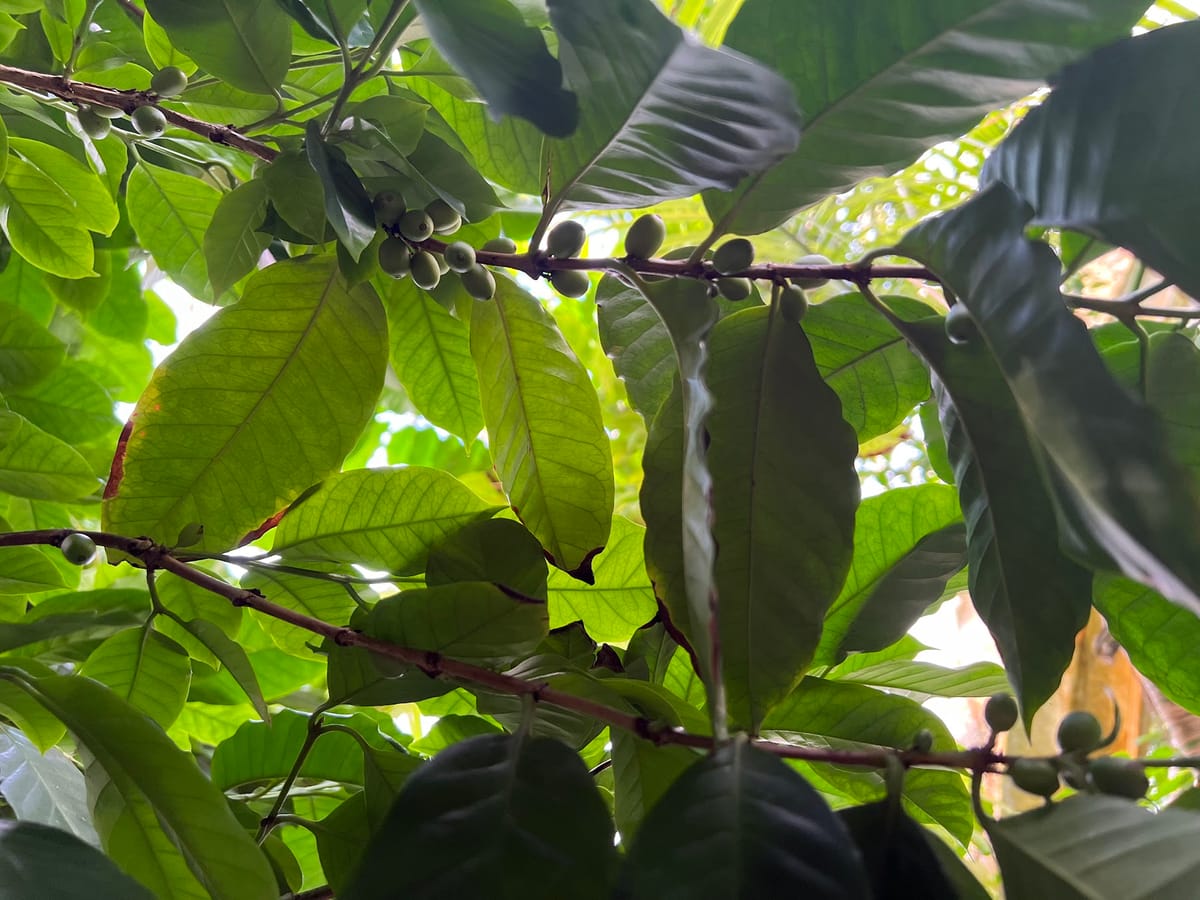
I've tried twice to grow coffee from seed at home and bought coffee plants on a few occasions. In this post, I want to document my attempts and what I've learned both for my own notes and in case other people want to give it a try.
If you haven't had a good look at a coffee tree before, here are some pictures I took at Kew Gardens in London. The tree they had in the greenhouse was coffea canephora (robusta), but they're also doing research on other species of coffee that may help protect coffee against threats from climate change.

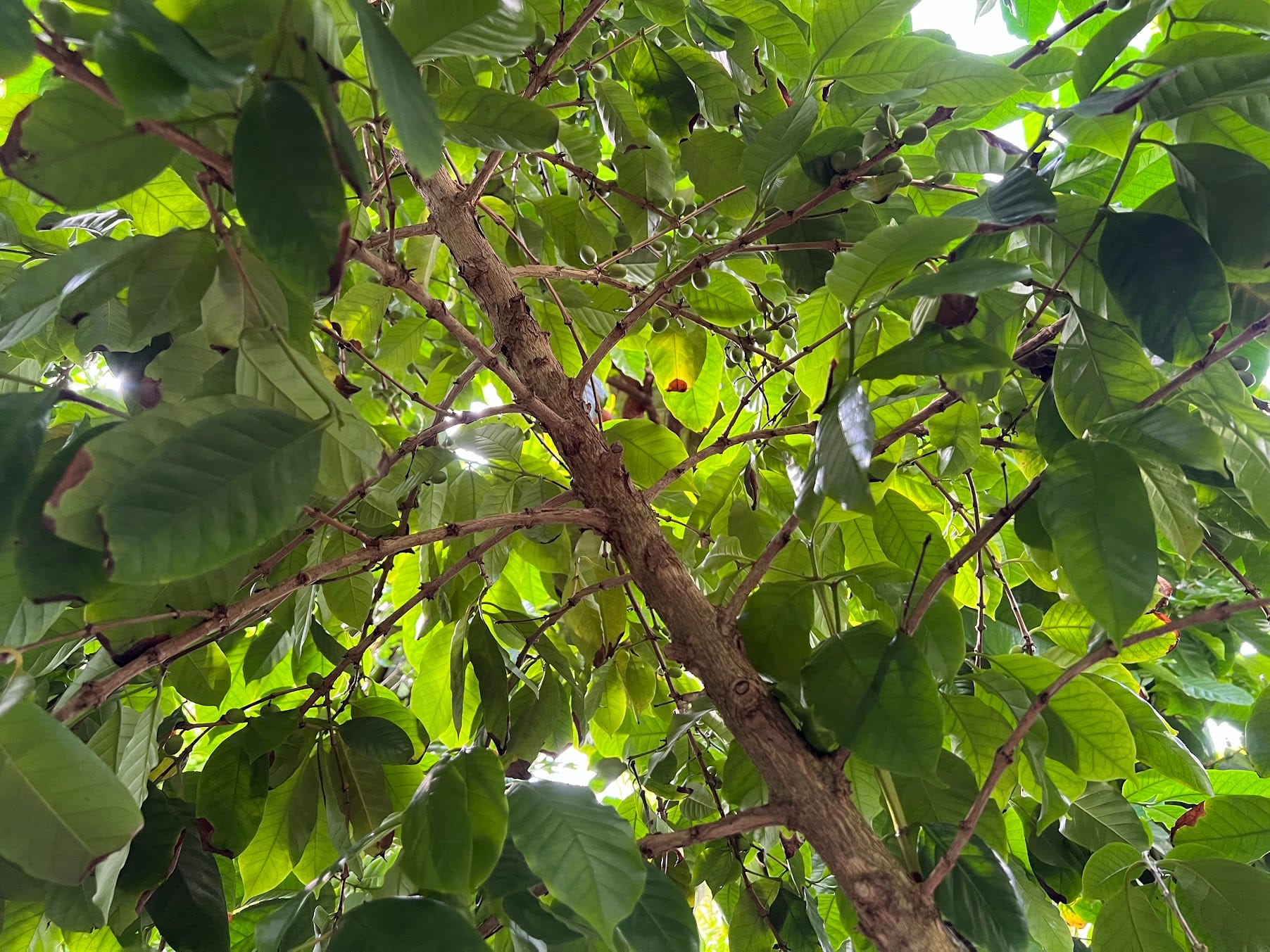

Kew Gardens is doing research on a species named coffea stenophylla that they hope will make coffee production more robust in the face of climate change.
On the surface, growing coffee sounds pretty doable: the coffee we drink is the roasted seed of the coffee plant after all, and Trader Joe's sold coffee plants as indoor house plants that one time. Since I have roaster friends around the Bay Area, it wasn't too hard for me to get access to coffee in different stages of processing to play with.
My First Try: Starting with Cherry
When I was taking classes at Boot Coffee Campus, they had a pair of coffee trees growing in a raised planter by the door. That tree had fresh fruit and flowers, and it was the first time I'd tasted coffee fruit.


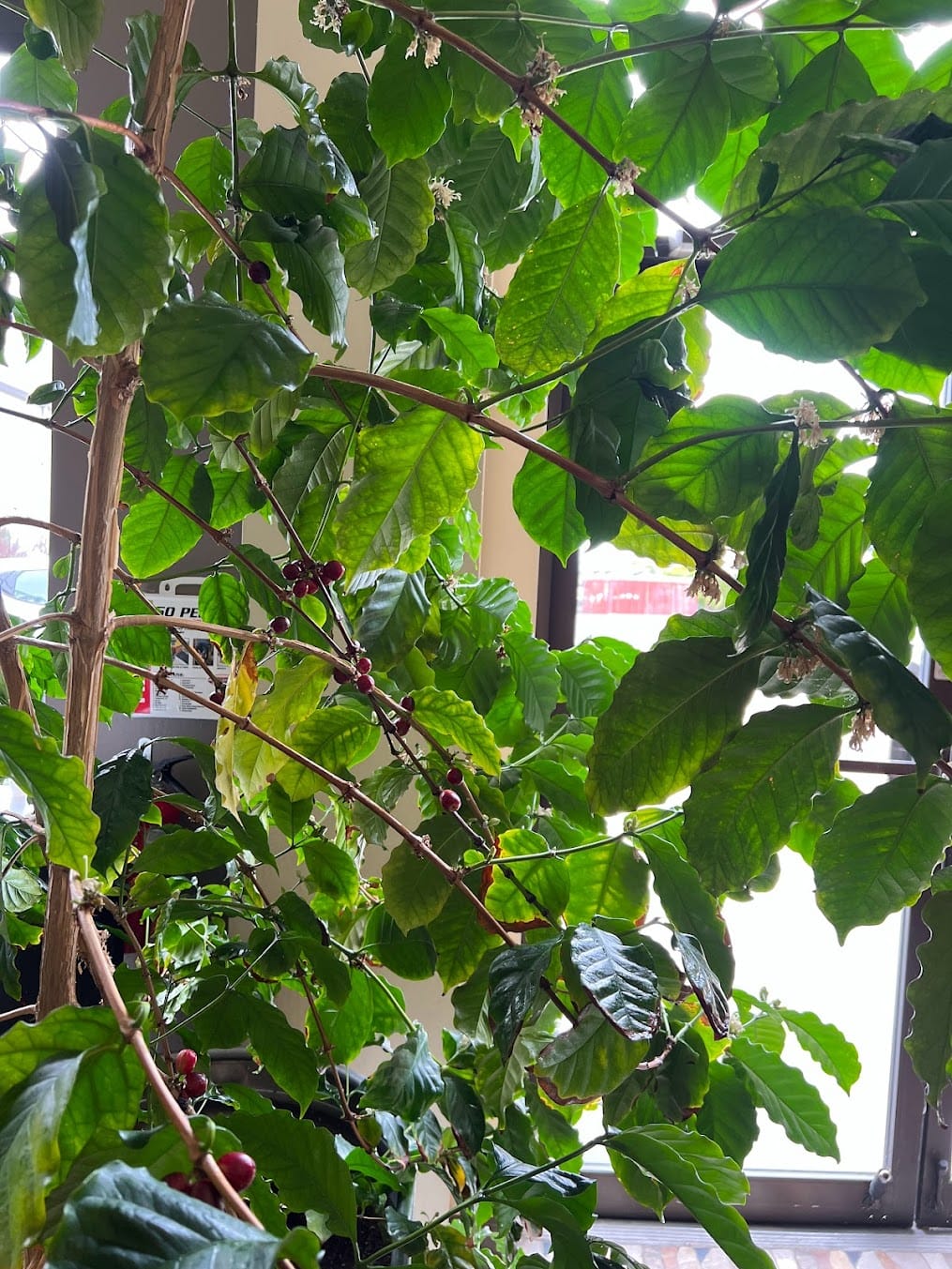
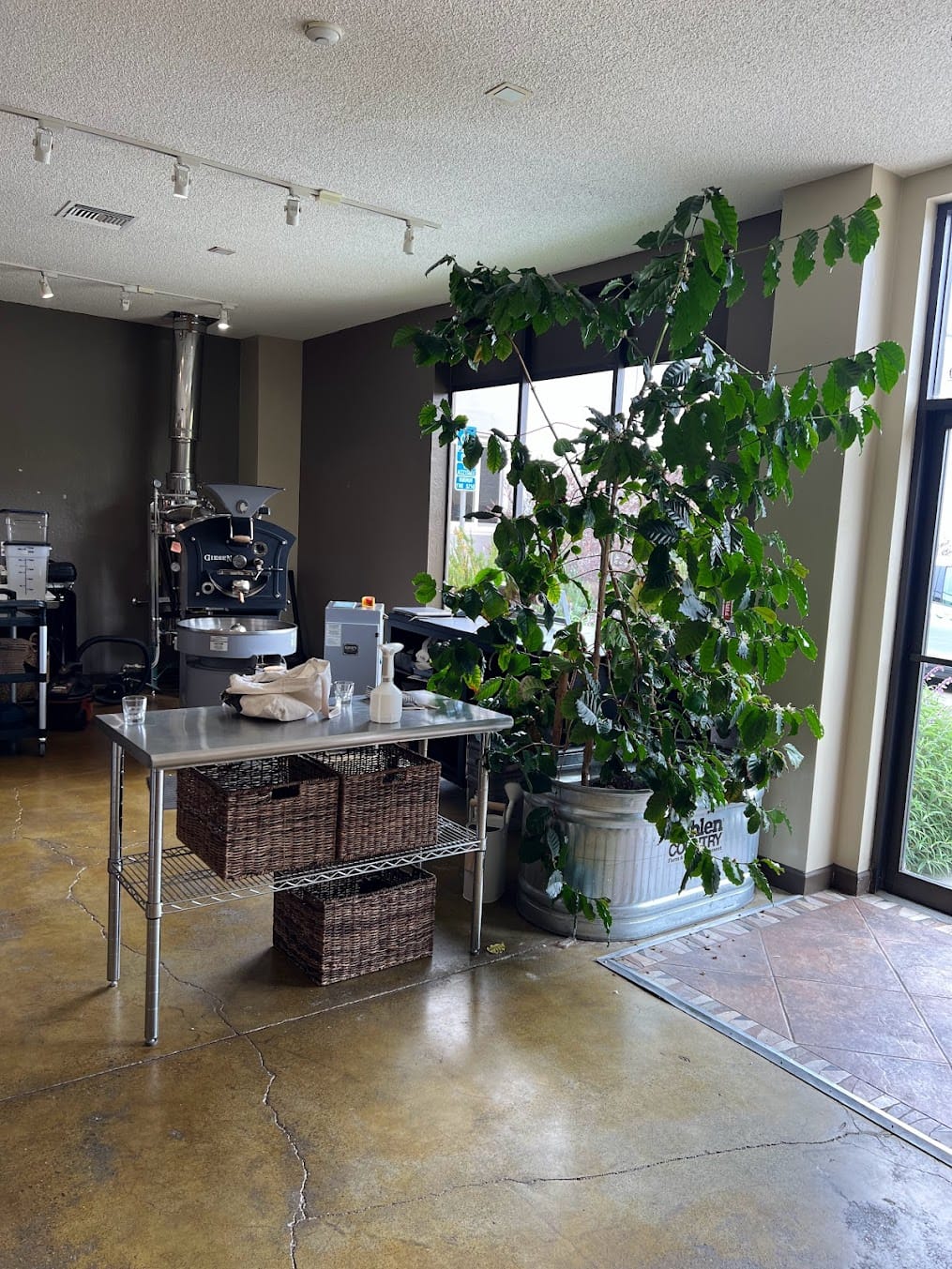
Various angles of the two coffee trees in the planter at Boot Coffee Campus, featuring my friend Ming from @moonwakecoffeeroasters for scale. The two trees are close together and their branches interleave, sot it's hard to see that there are two.
These trees are really beautiful in person. They have long, slender branches and the leaves hang off them in orderly rows like strung-up lanterns or dangling paper kites. The red fruits sit tantalizingly at every node, and the flowers held aloft by the branches catch every passing breeze and fill the area with a fragrance like strong jasmine and faint perfume.
Because I started from fresh fruit, the seed was still wrapped in a protective layer of parchment. This sturdy layer is removed during coffee processing, leaving the green coffee seed. I tried germinating the coffee in the parchment at first, and while it was slow, several of the seeds did manage to germinate that way. After a while, I got impatient and started soaking them in water. This greatly sped up the germination process and softened the parchment, allowing me to remove it manually.
I germinated them on the surface of the soil, which was tedious because I had to mist them every few days for weeks on end until they put roots into the soil. I considered just sandwiching them between some moist towels, but I feared that this would cause mold. It would also have been easier if I buried them in the soil and covered the seeding tray with a greenhouse cover (e.g. clear plastic lid) since the soil would keep them evenly moist without having to water them as often, however the downside is that you can’t see if they’ve germinated or not. Since it takes almost two months to germinate, it’s a long wait and I wanted to check that my seedlings were alive. For a grower with a lot of parchment coffee or whole cherry, a “spray-and-pray” approach where you bury 3 cherries in each nursery pot and then thin them down to one per pot after they germinate might be more efficient and reliable, but when you only have a handful of cherries and want to maximize the number of viable seedlings, you kinda want to baby them (perhaps more than is good for them).
Here are some photos of the germination process starting from the seeds that I extracted from the coffee fruit to the point where the seedlings unfurled their cotyledons (seed leaves).






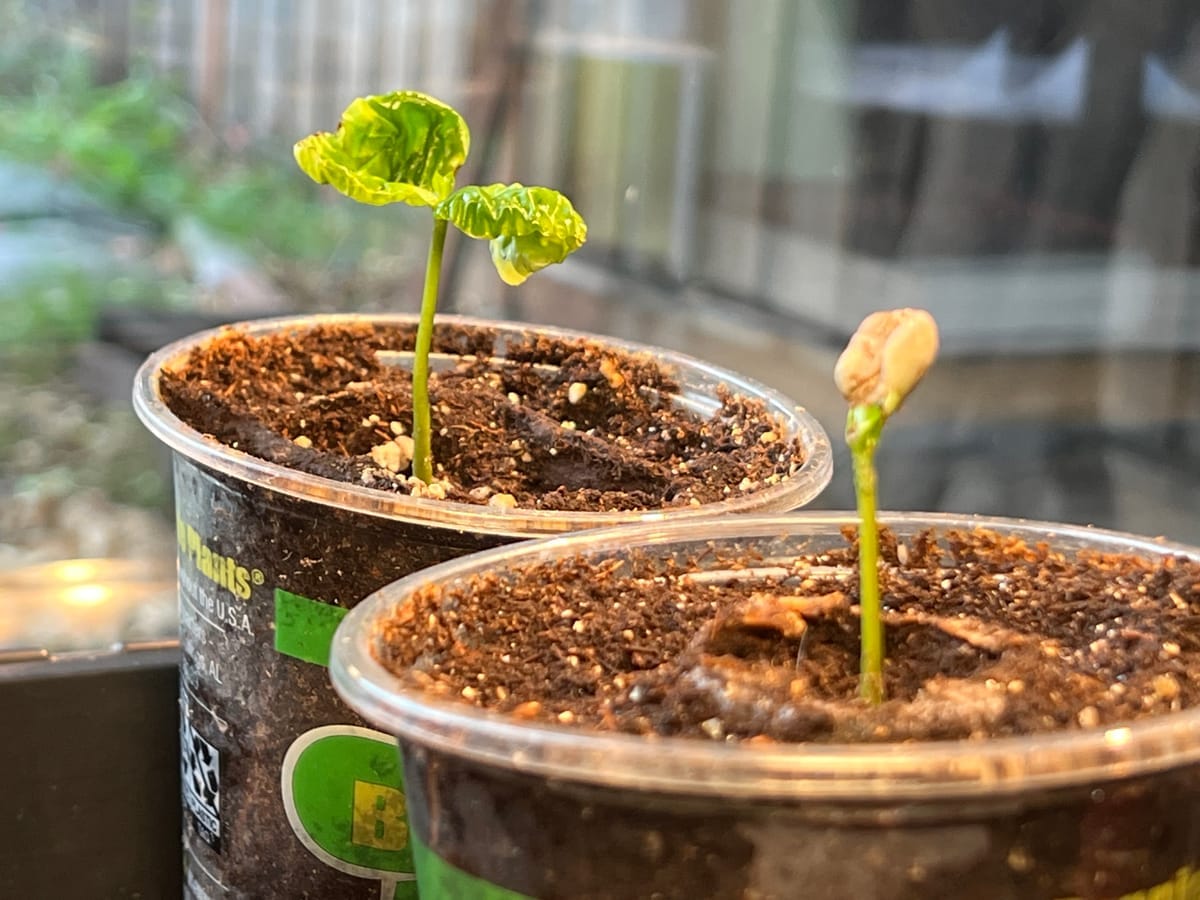
Here are photos showing coffee germinating from the seed (still encased in its parchment layer) to when they unfurled their cotyledons (seed leaves). From first to last: seeds in parchment, germinating in the seeding tray, two shots of the seedlings at the "solider" (bean on a pole) stage, cotyledons pushing out of the coffee bean, furled cotyledons after freeing themselves, and finally unfurled cotyledons (if you look closely, you can see a pair of tiny leaves in the center).
My attrition rate was really high. I started with about 12-15 seeds and ended up with two surviving plants. If I recall correctly, about 10 germinated, 6-8 made it to the soldier stage, and then 4 survived to put out true leaves. I think I could've improved my germination process, which would've given the plants more energy to grow through their early seedling stages.
Here they are putting out their first true leaves:
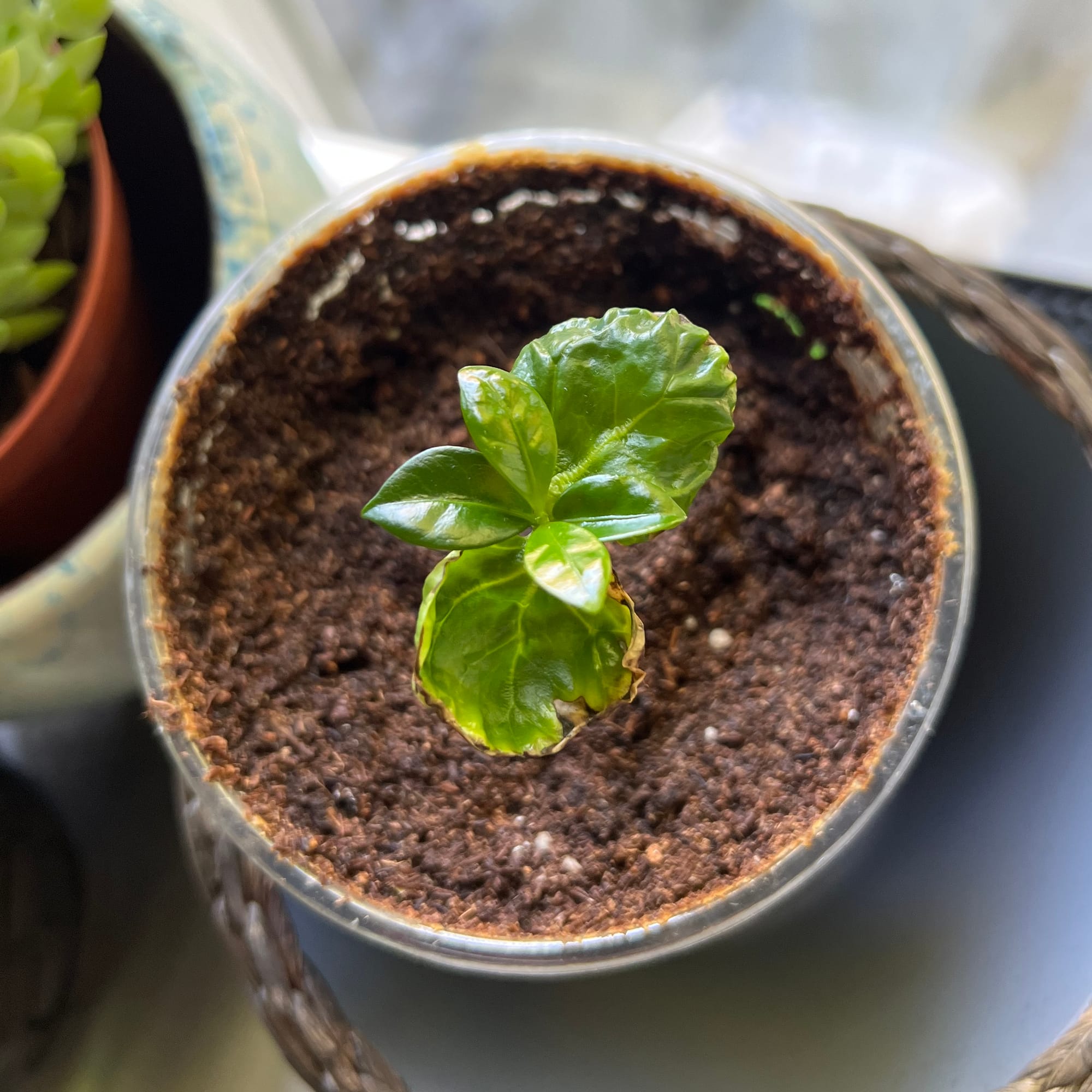

Two pictures of the seedlings showing their cotyledons (round seed leaves) and true leaves (pointy). If you look closely, you can see the tiny, pyramid shaped growth bud at the tip of the shoot.
Here's what they look like after a year of growth. You can see the round cotyledons as the lowest pair of leaves, but the plant has since grown several pairs of true leaves (which are pointed).
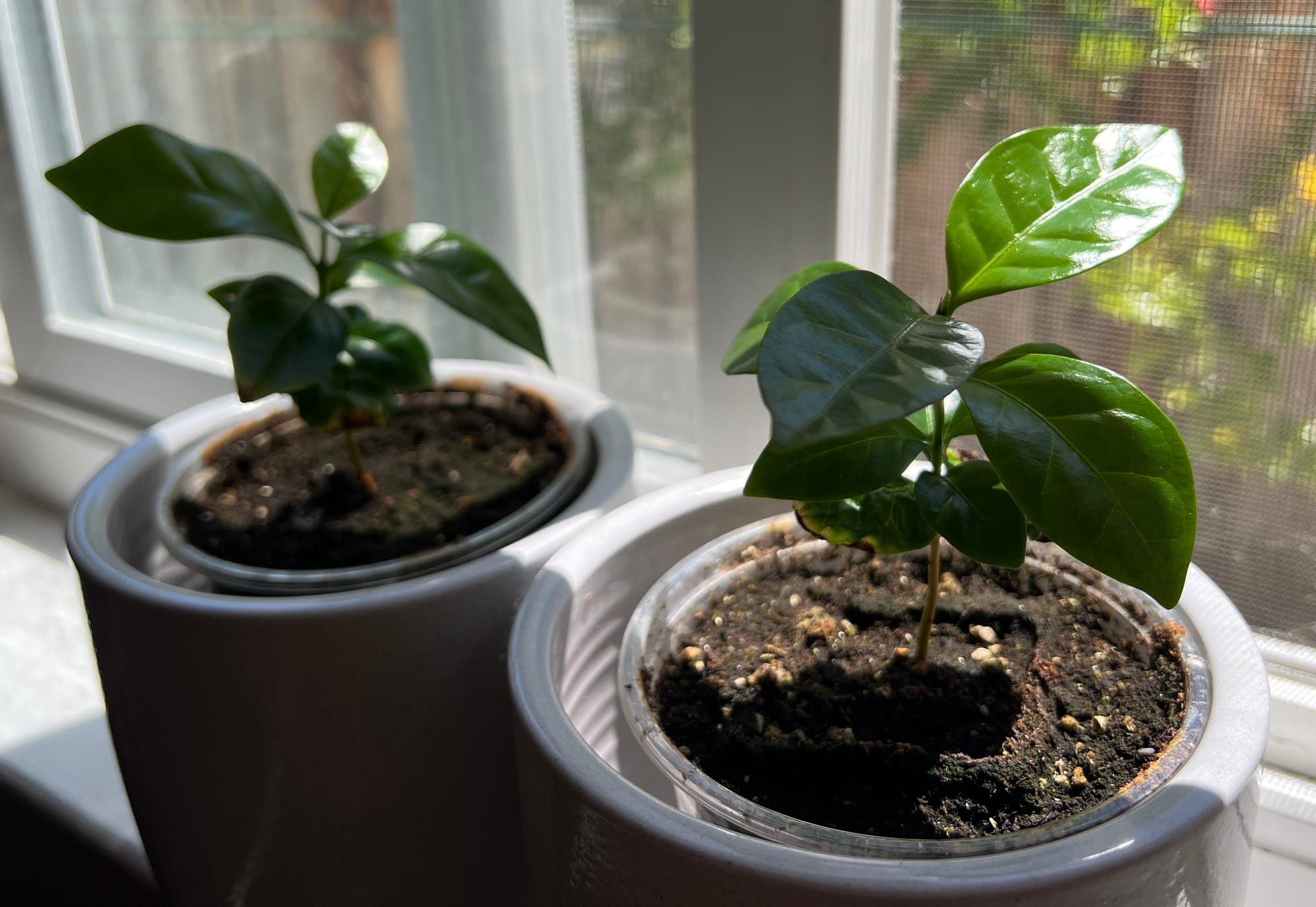
I suspect they're growing slower than they should, but my house is neither an Ethiopian cloud forest nor the Panamanian mountains, so I'll let them take their time.
My Second Try: Buying A Plant
I got impatient and figured I'd hedge my bets, so when I saw that FRINJ were selling coffee trees at SF Coffee Fest, I bought one. FRINJ is a California based coffee grower and one of the only producers in the continental United States. If anyone had trees that were well-adapted to the California climate, I figured it'd be them.
Some sources on the internet say that coffee plants take a few months to get to be a few inches tall, then within the first year, they should be around 2 ft. This lines up with the tree I got at Coffee Fest. I think it’s about a year old. All told, buying trees from FRINJ for $35 seemed like a good deal given how many hours of babying it took for me to get two viable plants from seed.
I had to carry the tree in my backpack across San Francisco and take it home on public transit, which was fun.

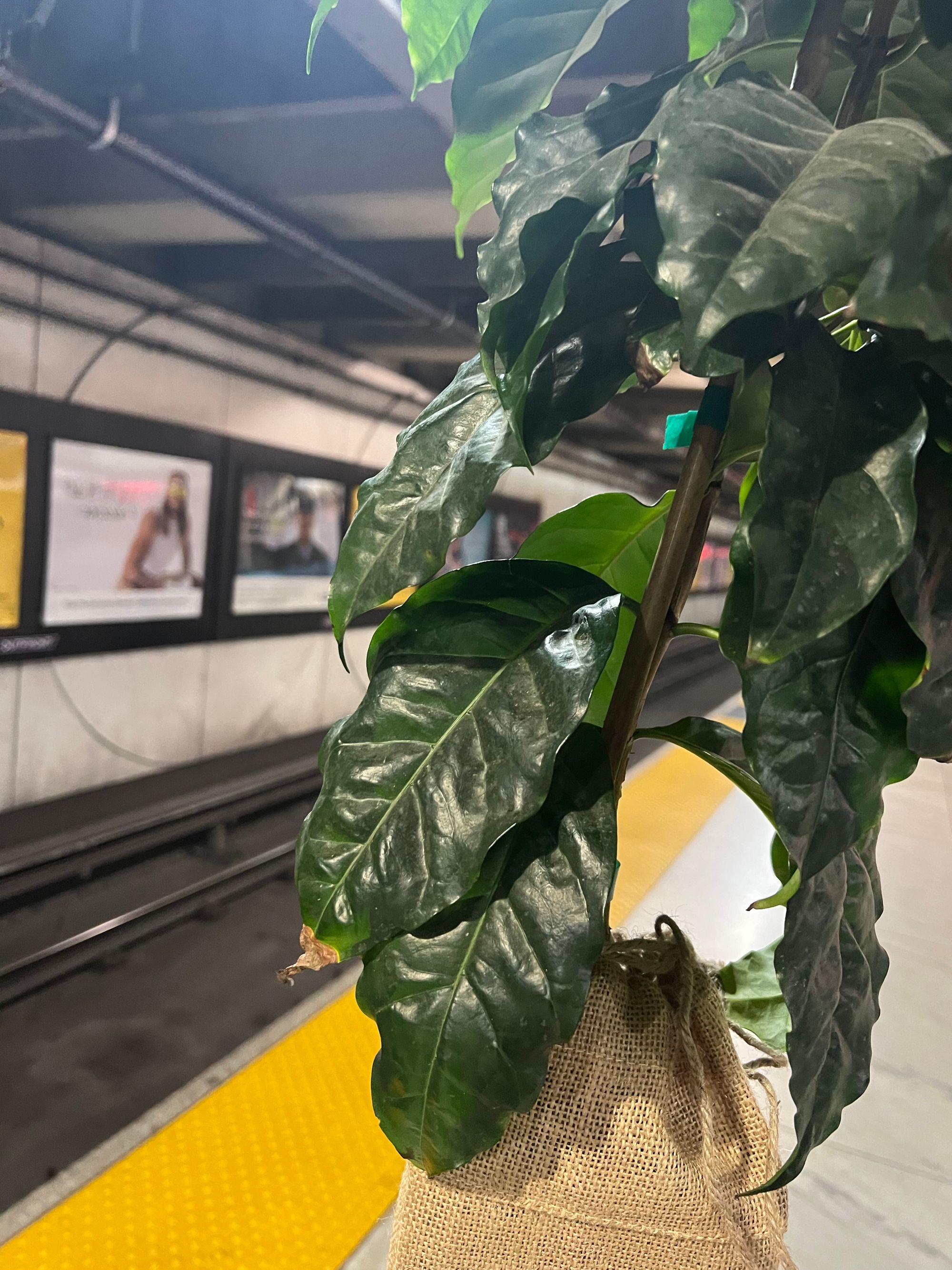
If you want a coffee plant of a variety actually known to produce good quality coffee, you can order one from them online – you don't need to grab it in person like I did. Unless you have a full-scale farming operation, it's unlikely that you'd grow enough coffee at home to process, roast, and brew for yourself, but I'm still debating growing a small coffee garden to have some demo plants to use as educational aids.


After a few months, my tree is still doing well and has put out new leaves. I up-potted it into a tree-sized nursery pot and it seems happy there.
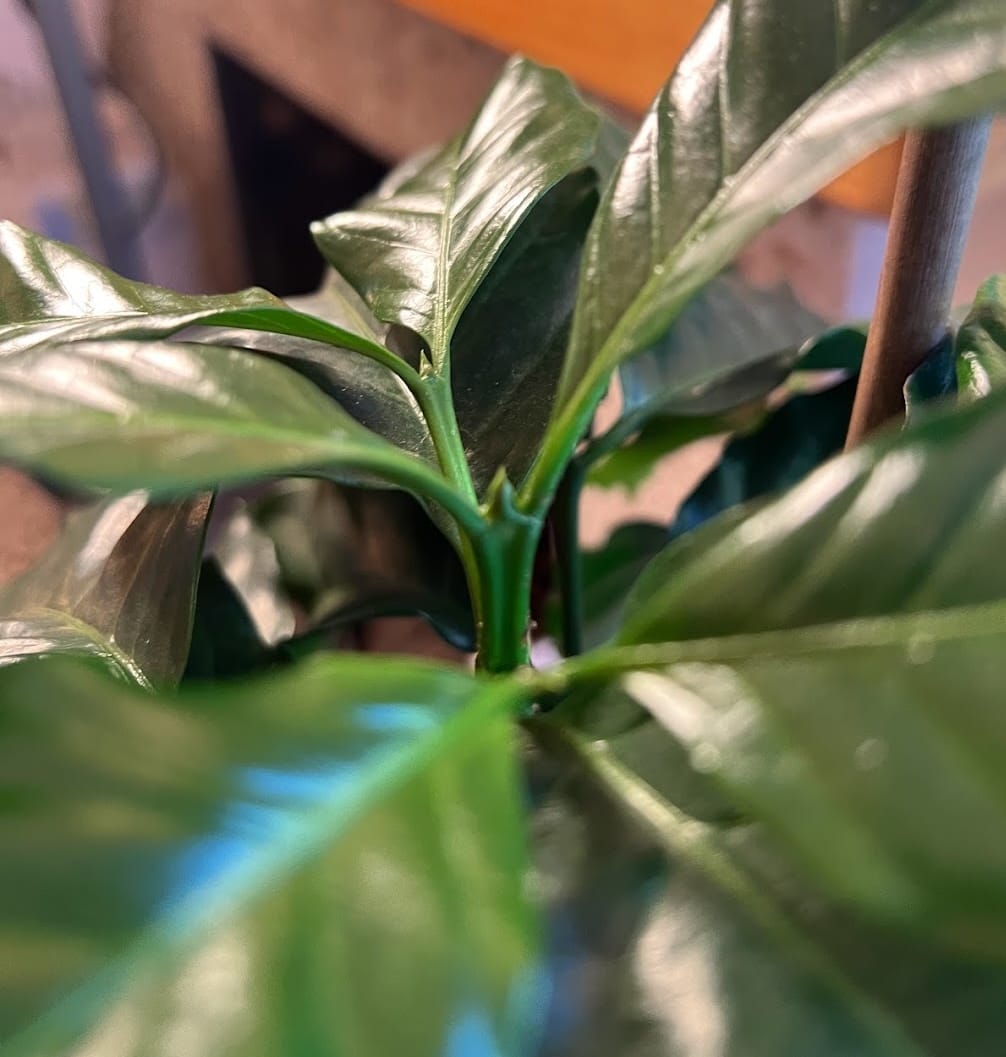
I put the planter on a rolling tray and wheeled it out for various coffee events. I find it easier to explain the process of creating coffee to people when they can see it as a plant instead of thinking about it as a bagged product.

Varieties
I’m unsure what any of the coffee plants I have are. I think the FRINJ one is Red Catuai because it has a red tag on it. The seedlings came from the two trees from Boot, but I’m unsure which they are: one tree was a gesha, the other is unknown. Maybe when they grow up I can try to identify them.

My Third Try: Germinating Green Coffee
Again, green coffee is just the coffee seed, removed from its outer layers. Some aggressive processing methods might chemically affect the seed, but processes like washed and natural coffees aren't too different than the processes that a coffee seed might encounter in the wild. I figured it was worth trying to get some green coffee to germinate. How cool would it be to be able to serve someone an excellent pour over and then show them a small plant germinated from the same coffee seeds?
Tom from Sweet Maria’s says he’s tried growing coffee from green but it doesn’t work for him (25-30% germinated, and about 1 in 50 germinated seeds actually grew). I soaked about 300 seeds and hoped to get at least one live start.
I read up on several guides on how to germinate green coffee, and settled on just soaking them until they put out embryos.

A good number of them actually germinated. I should've taken more detailed notes at the time, but I think about 30% of the green coffee I soaked germinated.



Soaking green coffee in water causes them to germinate. Even though the seed is able to eject its embryo, it's not a guarantee of viability.
For a moment I thought that I might actually succeed in getting a live plant out of this process given that I had over a hundred germinated seeds, however it takes a long time to go from germination to an established plant. The embryo needs to grow big enough to reach the soil, put down roots, and then grow a sprout strong enough to lift the seed off the ground. That can takes months.
Tom mentions that you should plant the seeds 1.5” deep in a pot that has space for a taproot (which adds up to a pretty deep pot). This tracks with the photos James Hoffman has in World Atlas of Coffee (on page ~18?) where there’s a grid of deep pots. The tree I got from FRINJ came in a roughly 4x4 by 12” deep nursery pot.
Thinking back to the seeds I started from parchment, I wondered if this had something to do with why a handful of my “soldiers” (seedlings at the “bean on a pole” stage) died. They’d start to grow black from where the embryo exits the seed and progressively blacken down the stem until the whole seed was drooping and the stem withered off. I started mine in seeding media: peat pellets and cardboard cells that you’re supposed to be able to directly transplant into the ground and let the roots grow through them. I think some of the plants did grow roots through the starting media when I repotted them into 4” round x ~6” deep nursery pots, but I wonder if some of the ones that died did so because they failed to grow through the cardboard/webbing at the bottom of the starter media.
The alternative theory is that the seeds got too wet during this stage and started to mold internally. I noticed that the ones that turned black and withered were less far along in escaping the bean. For one of them, I think watering it accelerated its death. I saw a speck of black on the stem and thought maybe if I sprayed water on the bean it’d help soften the parchment and outer layers, but instead it just died after a few hours.
So for this experiment, I decided to put them in a large seeding tray with a cover. I still wanted to be able to see the seeds so I could monitor their progress, but the large tray had a cover and would retain moisture better, hopefully reducing the amount of time I'd have to spend keeping them moist.
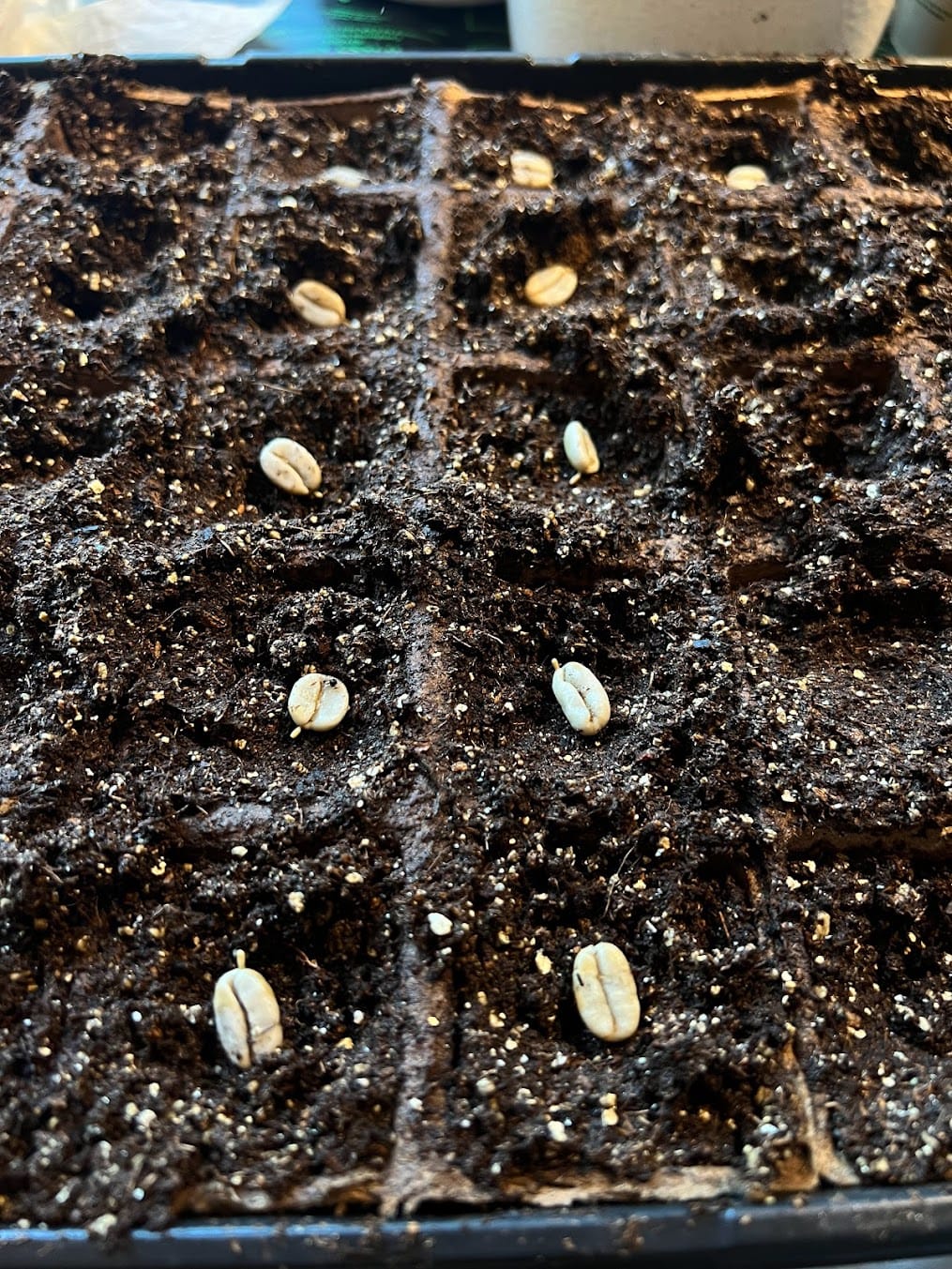

Things started going poorly almost immediately. After a day or two, some seeds were turning a dark blue-green color and getting slimey.

I kept them for a few weeks over the winter holidays, misting them occasionally. By the time New Year's rolled around, they were covered in mold. I'll spare you the photos – they're upsetting. I threw out the whole batch.
If I tried it again, I think I'd do it like Tom recommended and bury the germinated seedlings. That way, when some start molding, the spores are contained in the soil instead of being free to float around and infect other seeds. I'd also start with fresher green coffee than the ones I used.
I suspect that if I had been more selective with the seeds and only focused on the most viable ones (e.g. the ones that germinated fastest, had the best shape, least discoloration, etc.), I might have been able to keep them alive for longer. However, I didn't have time to turn this experiment into a project, so I had to leave it there.
Viability
While my seedlings were dying, I found a study from 2007 evaluating the viability of growing plants from green coffee.
In all samples that were hulled prior to storage, >50 % of the seeds lost viability within the first 3 months of storage. After 6 months, the fraction of seeds still viable was <10 %. After 1 year of storage, all seeds were dead (Fig. 2). The mode of processing had no effect on the time course of viability loss. In contrast, the so-called ‘pergamino’ or ‘parchment coffees’ (German: ‘Hornschalenkaffee’) revealed a different pattern. These coffee beans were stored within the parchment (endocarp) and, although these samples were derived from the same processing batch as the corresponding wet-processed samples, the loss of viability was quite different. Even after a longer storage period than 1 year, more than half of the beans stored as parchment coffee were still alive (Fig. 2).

These numbers approximately line up with the numbers Tom reported. Processing coffee can take 1-2 months, followed by potentially 1-2 months of transit. By the time the green coffee arrives, it could've been stored for 2-4 months. According to figure 2 from the paper, the researchers found about 20% of seeds to be viable, which roughly matches up with Tom's germination rate of 25-30%. That said, Tom reported that of the ones that germinated, only about 1 in 50 successfully sprouted. That puts us in the range of about half a percent for seeds surviving, which the researchers estimate would happen after about 9-12 months. Coffee is considered "past crop" after about a year, so I doubt that Tom was trying to germinate coffee that's 9 months past harvest (especially since he's an importer and would have access to a constant supply of fresh coffee).
The paper had one other interesting note:
Imbibition by coffee seeds that had died a number of months before resulted in a characteristic appearance. During imbibition by dead seeds, many, mainly brownish substances leaked out, due to the disintegration and decompartmentation of the seeds. In contrast, imbibition of seeds that had been dead for only a few days or weeks resulted in a quite different picture: 2–3 d after imbibition, the dead seeds had acquired a dark blue-green colour (Fig. 3A). The characteristic blue-green colour is known as viridinic acid (German: ‘Viridinsäure’). This results from the oxidation of chlorogenic acids and subsequent reaction with primary amino compounds (Watanabe et al., 1996; Yabuta et al., 2001). Similar reactions are frequently visible as the result of injuries that occur during wet processing, especially in the course of mechanical pulping and demucilation (Fig. 3B).
[...]
Direct contact of enzyme and substrates should be a precondition for such enzymatic oxidation; this may occur in the course of decompartmentation due to cell-death-related disintegration. As mentioned above, the formation of the blue-green compounds only took place in seeds that died within a short time period preceding evaluation. However, in seeds that had lost viability several months before imbibition, these oxidation-induced processes could not observed, although in all cases the tissues of the dead seeds would have disintegrated. Consequently, the enzymes that are responsible for the post-mortem oxidation of chlorogenic acids are still active in seeds that have died within a short period preceding imbibition. In contrast, these oxidative enzymes were already inactive in stale seeds because of denaturation processes that proceeded during the storage of dead seeds.
This explained the blue-green color I was seeing on my seeds and in the serum from soaking the seeds: these seeds had died, but relatively recently. The green coffee I used had been imported some months ago, in addition to however long it had been sitting after processing and in transit. They hadn't been sitting around for years (which could've deactivated the oxidative enzymes), but they'd also had plenty of time to lose viability.


Close up shots of the serum, showing blue-green viridinic acid. The first picture is front-lit against a white bag. The second is backlit, showing the gradient from blue-green to yellow-brown.
Conclusion
Having tried a few different methods for acquiring a coffee plant here are my thoughts:
- If you just want a decorative plant, just buy one. Many nurseries carry small coffee plants (around the size of my seedlings) that make good house plants.
- If you want a larger plant that might produce cherries, buy an established plant from a specialized coffee nursery or farm like FRINJ. This also ensures that you're getting a coffee plant of a specific, known variety. Many of the decorative coffee plants I've seen from general purpose nurseries only specify that the plant is coffea arabica (the species level) and don't list a variety because it's not likely to get big enough to produce fruit if it's grown in a small pot. As an educational tool, I'd want it to bear fruit, and it's better if I can explain what variety it is.
- If you plan to start from seed, buy seeds with the parchment (aka pergamino) layer still on. Unprocessed coffee seeds in the parchment are the most likely to be viable. You can get seeds in parchment of specific varieties from different nurseries and specialty seed shops. If you have a friend with a coffee tree, you can also ask for some cherry. Regardless of how you acquire your seeds, buckle up for a couple months of careful watering and waiting as you wait for them to push out of the ground.
As for me, I'm glad that I managed to get viable plants from the cherries I got at Boot. Those plants remind me of where I started this chapter of my coffee journey, and every time I see them, it reminds me of my instructors, my friends, and the memories I made taking classes there. Hopefully one day, my seedlings will grow into big trees that can produce their own cherries, and the cycle can continue.
Additional Links
For an introduction to Tom from Sweet Maria's, I like this podcast episode he did talking about his views about coffee tourism, as well as an episode he did with Lucia Solis discussing it.
For an introduction to Tom, I like this podcast episode he did about coffee tourism.
And also this episode by Lucia Solis chatting with Tom about that episode.



